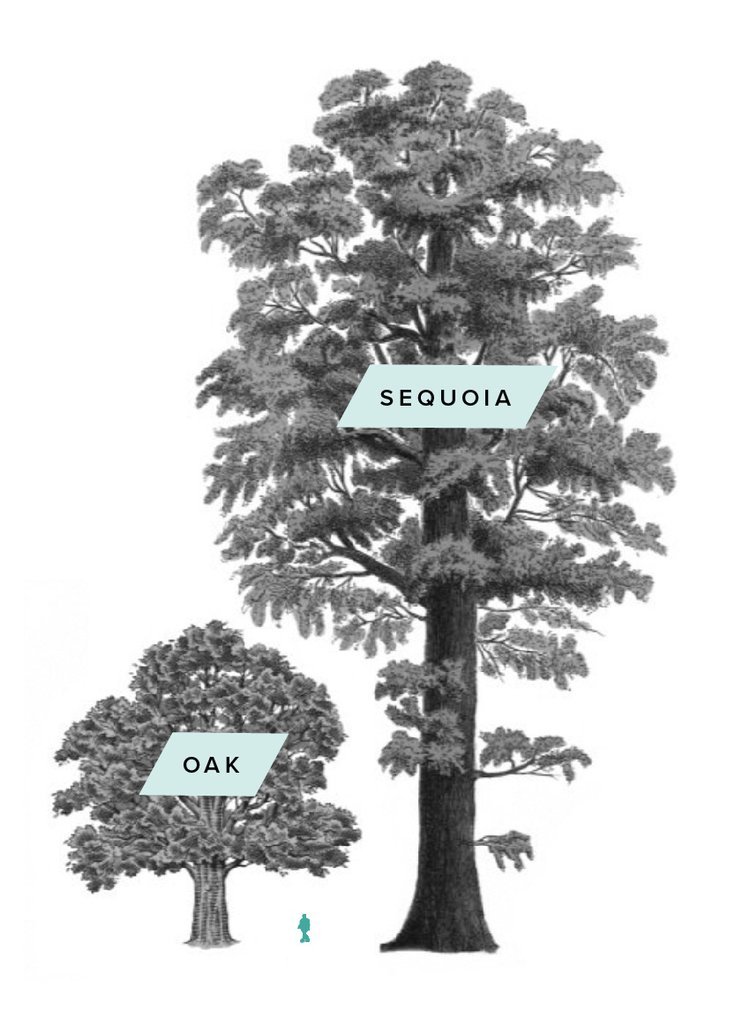
The Giant Sequoia
Sequoiadendron Giganteum / Giant Redwood / Wellingtonia
The Giant Sequoia (aka Giant Redwood) is the world’s largest tree species, as well as the fastest growing conifer. Famous sequoias have grown up to 300 feet tall, 36 feet wide, with volumes over 1400 m3, and are known to be as much as 3500 years old.
Ever seen a Giant Sequoia in the bark? Here is an approximate scale illustration of a mature Oak and Giant Sequoia. A Sequoia Grove can capture as much as 10x more CO2 per acre than a natural UK woodland over the period of 100 years, increasing over time. Each Sequoia is planted on a 100m2 plot. We plant 3 native UK species for each Sequoia to promote biodiversity.
UNDER THREAT
These magnificent trees are now on the IUCN Endangered Species Red List. Over 95% of their original numbers were logged for timber harvesting over the past 200 years. More recently however the impacts of climate change have been diminishing their numbers, which now stand today at an estimated 70,000.
Superheated wildfires caused by drought and excess forest debris are able to penetrate their thick red bark, causing fatalities of as many as 10% of their number per year.
Efforts to protect the old growth trees in their native US habitat are extensive, but the situation is challenging and not likely to improve.
Our efforts are to create a safe haven for the species in the UK by planting and protecting young Sequoias, to become the old growth groves of the future.
A GIANT SEQUOIA GROVE CAN CAPTURE UP TO 10X MORE CO2 PER HECTARE.
The UK Forestry Commission quotes that over 100 years a woodland planted today would sequest 400-600 tonnes of CO2 per hectare. A Sequoia grove where the trees were growing in line with SCC forecast data, where each tree could expect to reach a 100 year volume of 50 tonnes, across 100 trees would sequest over 5000 tonnes of CO2 from the atmosphere.
And Sequoia’s keep on growing. Meaning that they can capture more carbon far beyond our vintage terms.
The world is producing and burning fossil fuels on an industrial and massive scale. We must think about an industrial scale solution to match this problem. The world climate is changing rapidly and we need to act fast and at scale to reduce CO2 in the atmosphere. Giant Sequoias have the scale and land use efficiency to be part of the solution.
OUR TARGET FOR EVERY TREE
The largest Giant Sequoias in the UK today were planted around 170 years ago when the species was first discovered in the USA and seeds were brought back for specimen growth in large estates and gardens. Those trees today have reached diameters over 3.5m and heights over 50m.
Our target at The Great Reserve is to grow UK Sequoias to a trunk diameter of 3m+, and to heights of 200ft+, not far off UK specimens today that are still growing at 1.5ft per annum (referred to in The Guardian HERE).




